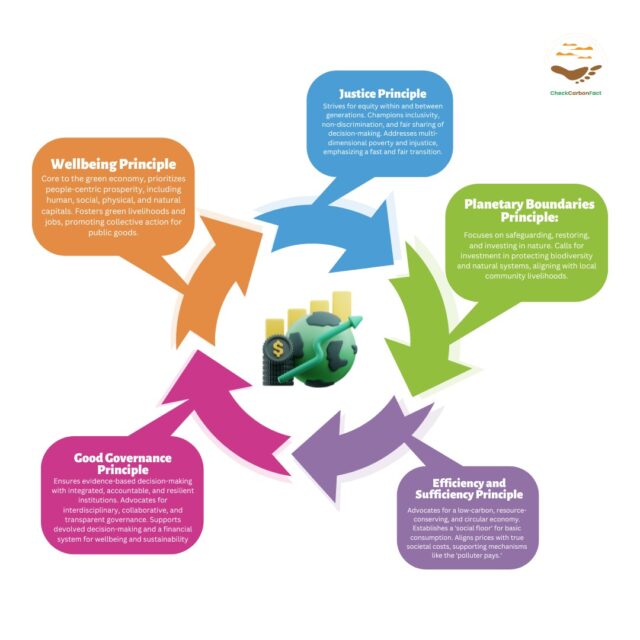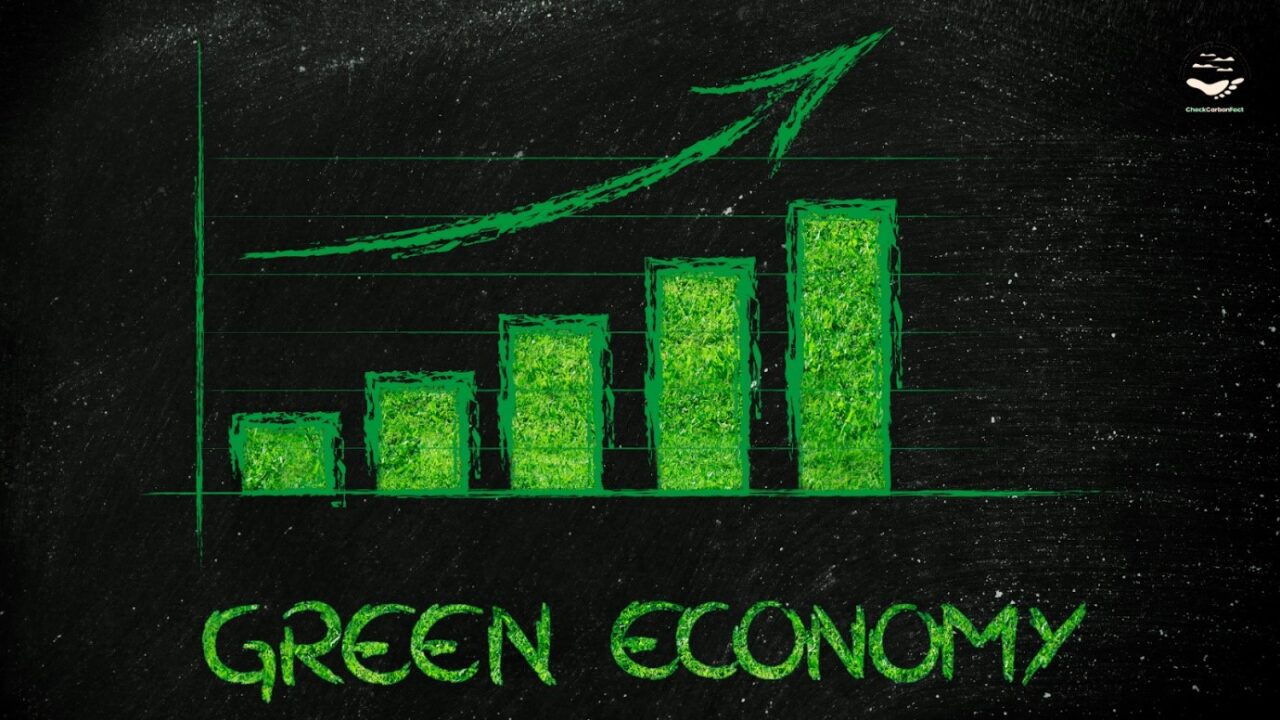In the face of daunting global challenges such as climate change, biodiversity loss, and growing inequality, the need for a transformative shift in our economic systems becomes increasingly evident. As a result, the concept of a Green Economy has gained significant traction in recent years.
At its core, the green economy seeks to integrate environmental and sustainability considerations into the traditional models of economic growth. The primary objective is to foster economic development and job creation while ensuring the responsible use of the Earth’s finite natural resources.
This blog post explores the nuances of the green economy, its core principles, benefits, and challenges.
Defining the Green Economy
The green economy can be defined as an economic paradigm that aims to improve human well-being and social equity while simultaneously reducing environmental risks and ecological scarcities. In simpler terms, a green economy is characterised by being low carbon, resource-efficient, and socially inclusive.
The term “green economy” was first introduced in a 1989 report ‘Blueprint for a Green Economy.’ Initially focusing on defining sustainable development and its implications. Subsequent reports broadened the scope to address global economic challenges like climate change and resource loss.
The global financial crisis in 2008 acted as a catalyst, prompting the United Nations Environment Programme (UNEP) to promote green stimulus packages, leading to the launch of the Green Economy Initiative. The green economy gained international recognition in 2010, with the UNEP Global Ministerial Environment Forum and the UN General Assembly designating it as a central theme for the 2012 Rio+20 Conference.
Green economy places a strong emphasis on reducing environmental risks and ecological scarcities, providing a sustainable alternative to the often exploitative practices of traditional economic models.
Unlike conventional economic models, which frequently prioritise immediate economic growth at the expense of environmental health, the green economy strives for a balance between development and ecological sustainability.
While traditional economic models tend to overlook the long-term consequences of resource depletion and environmental degradation, the green economy acknowledges the interconnectedness of economic progress and the health of our planet.
Key Principles of a Green Economy:
The principles of the green economy encompass five core elements:

- The Wellbeing Principle
At the core of a green economy lies the Wellbeing Principle, emphasising a people-centric approach. This principle seeks to create genuine, shared prosperity that extends beyond mere financial wealth. It encompasses human, social, physical, and natural capitals, prioritising investment in sustainable natural systems, infrastructure, knowledge, and education. By fostering green and decent livelihoods, enterprises, and jobs, the Wellbeing Principle promotes collective action for public goods while respecting individual choices.
- The Justice Principle
The green economy strives for equity within and between generations through the Justice Principle. This principle champions inclusivity, non-discrimination, and fair sharing of decision-making, benefits, and costs. It empowers women, reduces disparities between people, and ensures sufficient space for wildlife and wilderness. Taking a long-term perspective, the Justice Principle creates wealth and resilience for future citizens, urgently addressing today’s multidimensional poverty and injustice. Social justice, solidarity, and support for sustainable livelihoods are essential components, highlighting a fast and fair transition that leaves no one behind.
- The Planetary Boundaries Principle
Safeguarding, restoring, and investing in nature form the core of the Planetary Boundaries Principle. An inclusive green economy recognizes and nurtures nature’s diverse values, acknowledging the limited substitutability of natural capital. This principle calls for investment in protecting, growing, and restoring biodiversity, soil, water, air, and natural systems. It promotes innovative management of natural systems aligned with local community livelihoods based on biodiversity and ecological principles.
- The Efficiency and Sufficiency Principle
Geared towards supporting sustainable consumption and production, the Efficiency and Sufficiency Principle advocates for a low-carbon, resource-conserving, diverse, and circular economy. Recognizing the need for a global shift to limit natural resource consumption, it establishes a ‘social floor’ for basic goods and services consumption. This principle aligns prices, subsidies, and incentives with the true costs to society, promoting mechanisms where the ‘polluter pays’ and benefits accrue to those delivering inclusive green outcomes.
- The Good Governance Principle
Guided by integrated, accountable, and resilient institutions, the Good Governance Principle ensures evidence-based decision-making. Institutions supporting an inclusive green economy are interdisciplinary, collaborative, and coherent, operating horizontally across sectors and vertically across governance levels. Public participation, transparency, democratic accountability, and freedom from vested interests are crucial for enlightened leadership complemented by societal demand. This principle also advocates for devolved decision-making and a financial system designed to deliver wellbeing and sustainability.
Benefits of the Green Economy
The transition to a green economy offers a range of benefits across environmental, economic, and social dimensions:
- Environmental Benefits: First, it will lead to a significant decrease in carbon emissions and pollution, leading to cleaner air and water. Also, it multiplies our efforts to preserve biodiversity and ecosystems.
- Economic Benefits: Transiting to a green economy will significantly contribute to the creation of new markets and job opportunities in renewable energy, sustainable agriculture, and green technology sectors. In addition, it will lead to an increased investment in green technologies, leading to cost savings over time through improved efficiency and lower energy costs.
- Social Benefits: Lastly, it will lead to a reduction in environmental hazards and pollution directly impacting public health. There is also a community development aspect of it. We will have increased job opportunities and skills training for disadvantaged communities, greatly reducing global inequality.
Challenges and Criticisms
Despite its potential benefits, the green economy is not without challenges and criticisms. Let’s dig into the most profound.
-
Financial Challenges:
- High Initial Investment: The transition from traditional to green industries often demands substantial investments in new technologies, renewable energy infrastructure, and sustainable practices. Developing countries, in particular, may struggle with limited financial resources to fund these expensive transitions.
- Job Losses: Shifting away from traditional industries, such as fossil fuel-based sectors, can lead to short-term job losses. This economic strain can be a significant obstacle, particularly in regions heavily dependent on these industries.
-
Political and Policy Barriers:
- Resistance from Established Industries: Industries with vested interests in fossil fuels may resist the adoption of green policies, often due to economic dependencies and political influence. Overcoming this resistance requires navigating complex political landscapes and establishing a clear path toward a sustainable future.
- Lack of Consistent Policies: Inconsistency in environmental regulations and standards across regions poses a challenge. Differing policies can create complications for multinational companies and hinder international collaboration on sustainable practices.
-
Technological Hurdles:
- Need for Development: While advancements in green technologies are occurring, there is an ongoing need for significant development in certain areas, such as energy storage and efficiency. Overcoming technological barriers is crucial for the widespread adoption of sustainable practices.
- High Costs: The high initial costs of some green technologies can be a limiting factor, especially in sectors where fossil fuels remain economically viable. Lowering these costs and improving the accessibility of green technologies is essential for their broader acceptance.
-
Criticisms and Limitations:
- Overconsumption: Critics argue that the green economy, by focusing on sustainable practices within the existing economic framework, may not address the root cause of environmental issues—overconsumption. Some contend that the concept might merely ‘greenwash’ economic growth without challenging fundamental consumption patterns.
- Market-Based Solutions: There are concerns that relying solely on market-based solutions may not be sufficient to tackle pressing environmental crises. Critics suggest that more radical changes in economic and social systems may be required to address the magnitude of the challenges.
The Future is Here
In conclusion, the green economy signifies a profound shift towards sustainable development, marked by advancements in renewable energy technology and improvements in energy storage. Despite challenges, global policy changes towards environmental sustainability, including stricter regulations and incentives for green technologies, are accelerating this transition. Crucially, the increasing consumer demand for eco-friendly products is compelling businesses to invest in sustainable development, prompting broader participation from the private sector. Overall, achieving a green economy hinges on collective efforts, and with the ongoing momentum, it is imperative not to be left behind in this transformative journey.
About CheckCarbonFact
CheckCarbonFact is a social accountability platform for climate action by citizens, companies, and governments. It is a UK-based enterprise with a focus on engendering collective responsibility and mutual accountability in climate change mitigation and adaptation. The vision of CheckCarbonFact is to mobilise collective action in the race to save the planet; and the mission is to deter greenwashing, empower sustainable consumerism; and address climate inequities and inequality.
Found it interesting and would like more in the mail?




